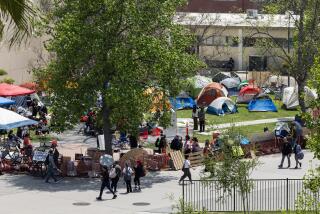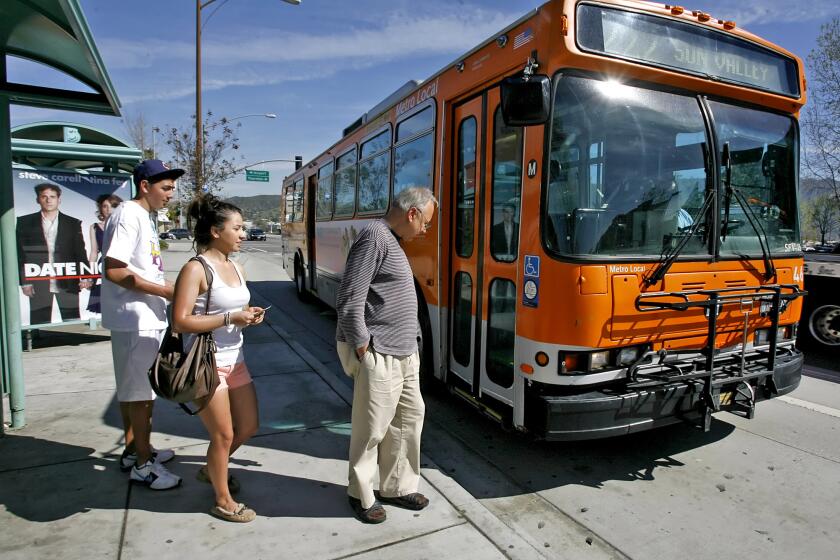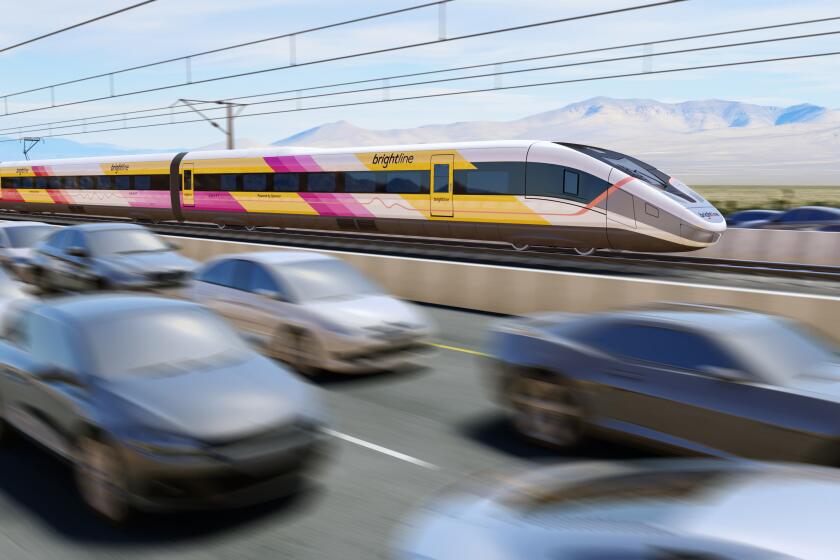Short-Circuiting Traffic Shortcuts
Traffic-weary motorists who try to get around freeway congestion by cutting through residential streets will face a bumpy road if many Los Angeles homeowners get their way.
Frustrated with increased speeding through their neighborhoods, homeowners throughout the city requested speed humps on 350 streets in the last 12 months, nearly 50% more applications than in the previous fiscal year, according to city officials.
Traffic experts say the surging demand for humps--those raised asphalt mounds designed to slow traffic--is mostly the result of worsening freeway snarls that have many motorists seeking shortcuts on surface streets.
It’s not just Los Angeles that is experiencing speed-hump proliferation. Homeowners nationwide are turning to humps and other “traffic calming” devices, such as stop signs and landscaping, to combat speeders in residential areas, said Kay Fitzpatrick, a traffic engineer with the Texas Transportation Institute, who co-wrote a book on the devices.
The city of Los Angeles has installed humps on 404 streets since 1994. Not every request is granted. But in response to the growing demand, city officials expect to install the humps on an additional 235 streets in the next year and a half.
“The demand for speed humps continues to rise significantly,” said Pauline Chan, a senior engineer with the Los Angeles Department of Transportation. She said she knows of no other city with so many speed humps.
But some homeowners who live near the humps say the traffic-slowing devices have not put them on easy street.
“People who drive SUVs see the humps as more of a challenge than a hindrance,” said Larry Davis, a packaging materials consultant who lives near a set of humps on Castle Heights Avenue in the Cheviot Hills area.
One of Davis’ neighbors, Judy Swartz, who works at a Westside newspaper, agreed.
“I don’t think it slows people much, except for trucks,” she said as a stream of cars flew over the humps near her driveway, producing a rhythmic thumping sound.
Still, Chan said, the growing demand for the humps has her department scrambling to come up with the money needed to install the devices, which cost about $4,500 for each block. Because of the backlog, Chan said residents who submit applications for the humps must wait a year or more before street crews can construct the mounds of asphalt.
Speed humps are often confused with their more jarring cousin, the speed bump. Humps peak at about three inches above street level and stretch for up to 12 feet. That is a mild enough incline to spare automotive underpinnings. But traffic experts say it is abrupt enough to slow drivers to less than 25 mph. Speed bumps, on the other hand, are taller and more compact, designed to keep vehicles under 10 mph.
Throughout Southern California, the proliferation of speed humps has sparked controversy, mostly because of concerns that police and fire vehicles can be slowed in racing to emergencies.
In recent years, the private communities of Coto de Caza and Dove Canyon in Orange County have removed speed humps because of fire officials’ concerns. Other cities, including Berkeley and Boulder, Colo., have placed moratoriums on new speed humps while they study their effect on emergency vehicles.
But a spokesman for the Los Angeles Fire Department said the humps cause minimal delays.
“It doesn’t really impact us that much,” said Battalion Chief Daryl Arbuthnott, noting that the humps are not usually installed on major thoroughfares.
The requests for speed humps usually come from residents who file petitions with the city Department of Transportation. Before the humps are installed, the department must determine that speeding is a problem on the street in question and that the humps will not cause safety hazards for motorists or emergency vehicles. Chan said the department typically approves about half of the petitions.
The problem of residential “cut-through” traffic is usually worse in neighborhoods near busy thoroughfares and freeways. And many homeowners say it has gotten worse in recent years.
“It has really degraded the lifestyle in some neighborhoods,” said Robert Ringler, a member of the Community Police Advisory Board in West Los Angeles. “These people are not polite. They tailgate just to save a second.”
A computer analysis of the 404 streets with speed humps shows that they are distributed relatively evenly throughout the city, with some denser pockets on the Westside, in South Los Angeles and in the San Fernando Valley.
Heavy concentrations are also located in residential neighborhoods in the foothills of the Santa Monica Mountains--corridors many motorists use to avoid the San Diego Freeway as they travel between the Valley and the Westside.
Nearly a third of all the speed humps are in the districts of City Council members Cindy Miscikowski and Jack Weiss, which stretch from the Westside to the Valley. Weiss said that “cross-mountain” traffic has become a top concern among his constituents.
Another explanation for the clusters of humps in those neighborhoods: Many affluent homeowners are willing to pay for the humps themselves, rather than wait a year or longer for the city to get the work done.
Homeowners in those two council districts paid to install speed humps on 25 streets. Developers who built or expanded commercial projects in the area paid for humps on 14 other streets, according to city records.
But speed humps are not exclusive to high-income neighborhoods.
Another cluster is in Watts, where most of the humps are on streets that bisect and circle the five subsidized housing projects there.
Chan said many of the Watts speed humps were paid for by a special neighborhood improvement initiative launched by former Mayor Richard Riordan.
Despite the demand for speed humps, many people have mixed feelings about them.
Cheviot Hills resident Leona Sugar said the speed humps installed about three years ago near her home on Beverly Drive have made a difference. Now, she said, she can back out of her garage without worrying about getting hit by a reckless speeder.
“People who cut through my neighborhood have really slowed down,” said the 21-year Westside resident.
But her husband, Philip, a lawyer, is not so certain. He worries that motorists speeding over the humps could lose control of their vehicles and crash.
“I don’t think that speed humps work,” he said.
Davis, who lives on nearby Castle Heights, said the humps seem to be effective only at slowing moving vans, delivery trucks and other large vehicles carrying heavy loads.
But even then, the humps are an annoyance because neighbors must endure the jolting sound of metal tools, equipment and other cargo jostling around in the back of a bouncing truck, he said.
“I don’t think ours work, because they are not high enough,” he added.
Another Castle Heights homeowner said the best solution to the speeding problem is increased police patrols to cite offenders.
“Putting obstacles in the way doesn’t dissuade people from going through,” said the homeowner, who declined to give his name.
Sherman Oaks has 15 streets with speed humps. But Richard Close, president of the Sherman Oaks Homeowners Assn., said not everyone agrees that the humps have been effective.
“People want them on their streets in order to discourage cars from their street,” he said. “But all that does is shift cars to another street.”
As the speeding problem migrates from one street to another, Close said, the demand for speed humps grows.
“Soon we are going to have these bumps everywhere,” he said, “and you won’t be able to use any residential streets.”
Times staff writer Doug Smith contributed to this story.
(BEGIN TEXT OF INFOBOX / INFOGRAPHIC)
Bumpy Roads
Demand for speed humps from homeowners throughout Los Angeles surged last year in response to the growing problem of motorists using residential streets as alternatives to crowded freeways. Map shows the location of the 404 streets with speed humps.
*
Humps and bumps
* Speed bumps are three to six inches tall and usually found in parking lots. They are typically more jolting to a vehicle and are intended to keep speeds under 10 mph.
* Speed humps are longer and flatter than speed bumps and are less than three inches tall and up to 12 feet long. They are designed to keep speeds to about 25 mph.
* Speed tables are long, raised speed humps with a flat section in the middle and ramps on the ends. They are about 22 feet long and are designed to keep speeds under 30 mph.
*
Source: Los Angeles Department of Transportation
Speed humps requested and installed, by fiscal year:
*--*
Requested Installed 2001 350 n/a 2000 230 69* 1999 162 123 1998 149 37 1997 n/a 76 1996 105 32 1995 113 32 1994 66 23
*--*
*
* To be installed this fiscal year.
More to Read
Start your day right
Sign up for Essential California for news, features and recommendations from the L.A. Times and beyond in your inbox six days a week.
You may occasionally receive promotional content from the Los Angeles Times.







